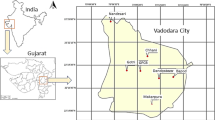Abstract
There is a need for timely information about changes in the air pollution levels in cities for adopting precautionary measures. Keeping this in view, an attempt has been made to develop a model which will be useful to obtain air quality information directly from remotely sensed data easily and quickly. For this study pixel values, vegetation indices and urbanization index from IRS P6 LISS IV and Landsat ETM+ images were used to develop regression based models with Air Pollution Index (API), which were calculated from in-situ air pollutant information. It was found that among the 12 parameters of IRS, highest correlation exists between pixel values in NIR (Near Infra-Red) band (Pearson correlation −0.77) and Normalized Difference Vegetation Index (NDVI) (Pearson correlation −0.68) and both have inverse relationship with API. In case of Landsat, the highest correlation was observed in SWIR (Short Wave Infra-Red) band (Pearson correlation −0.83) and NIR (Pearson correlation −0.78). Both single and multivariate regression models were calibrated from best correlated variables from IRS and Landsat. Among all the models, multivariate regression model from Landsat with four most correlated variables gave the most accurate air pollution image. On comparison between the API modeled and API interpolated images, 90.5 % accuracy was obtained.






Similar content being viewed by others
References
Ahmad, A., Hashim, M., Hashim, Md. N., Ayof, Md. N. & Budi, A. S. (2006). The Use of Remote Sensing and GIS to Estimate Air Quality Index (AQI) Over Peninsular Malaysia. Proc. Map Malaysia 2006, held in Kuala Lumpur, Malaysia.
Bell, M. L. (2006). The use of ambient air quality modeling to estimate individual and population exposure for human health research: a case study of ozone in the Northern Georgia Region of the United States. Environmental International, 32(5), 586–593.
Boken, V. K., Hoogenboom, G., Williams, J. H., Diarra, B., Dione, S., & Easson, G. L. (2008). Monitoring peanut contamination in Mali (Africa) using the AVHRR satellite data and a crop simulation model. International Journal of Remote Sensing, 29(1), 117–129.
Chander, G., & Markham, B. (2003). Revised Landsat-5 TM Radiometric calibration Procedures and Postcalibration Dynamic Ranges. IEEE Transactions on Geoscience and Remote Sensing, 41(11), 2674–2677.
Deering, D. W., Rouse, J. W., Iiaas, R. H. & Schell, J.A. (1975). Measuring forage production of grazing units from landsat MSS Data. Proceedings of the Tenth International Symposium on Remote Sensing of Environment, 2, 1169–1178.
Hogda, K. A., Tommervik, H., Solheim, I., & Lauknes, I. (1995). Mapping of air pollution effects on the vegetation cover in the Kirkenes Nikel area using remote sensing. Proc. Geoscience and Remote Sensing Symposium, IGARSS 95. Quantitative Remote Sensing for Science and Applications, 2, 1249–51.
Lautenschlager, L. F., & Perry, C. R. Jr. (1981). Comparison of vegetation indices based on satellite-acquired spectral data. Available from www.amstat.org/sections/srms/proceedings/papers/1981_017.pdf. [cited 20 June 2012]
Manawadu, L., & Samarakoon, L. (2005). Identification of Air Pollution Potential Areas and its Temporal and Spatial Patterns of the City of Colombo, Sri Lanka Applying GIS and RS. Proc. The 26th Asian Conference of Remote Sensing (ACRS), held in Hanoi, Vietnam.
Mourad, M., Bertrand-Krajewski, J. L., & Chebbo, G. (2005). Calibration and validation of multiple regression models for stormwater quality prediction: data partitioning, effect of dataset size and characteristics. Water Science and Technology, 52(3), 45–52.
Negi, H. S., Kulkarni, A. V., & Semwal, B. S. (2009). Estimation of snow cover distribution in Beas basin, Indian Himalaya using satellite data and ground measurements. Journal of Earth System Science, 118(5), 525–538.
Patil, U., Raavan, S., & Kaushal, A. (2003). GIS based air pollution surface modeling. GIS Development, 7, 45–47.
Pummakarnchanaa, O., Tripathi, N. & Dutta, J. (2005). Air pollution monitoring and GIS modeling: a new use of nanotechnology based solid state gas sensors. Science and Technology of Advanced Materials, 6, 251–255.
Rahmatizadeh, S., Mesgari, M. S., & Motesaddi, S. (2006). Air pollution modelling with geostatistical analysis. Proc. Map India 2006.
Rao, M. N., & Rao, H. V. N. (2001). Air pollution (pp. 268–271). New Delhi: Tata McGraw Hill Publishing Company Limited.
Rao, M. P. V., Hima Bindu, V., Sagareshwar, G., Indracanti, J., & Anjaneyulu, Y. (2004). Assessment of Ambient Air Quality in the Rapidly Industrially growing Hyderabad Urban Environment. Proc. BAQ 2004, Workshop Program and Presentation, Poster 3.
Ruru, D., & Shouping, X. (2005). The Coupled Model of Atmosphere and Ground for Air Pollution Remote Sensing and Its Application on Guangdong Province, China. Proc. Geoscience and Remote Sensing Symposium, IGARSS’05, IEEE International, 7, pp. 5133–5136.
Scaramuzza, P., Micijevic, E., & Chander, G. (2004). SLC Gap-Filled Products Phase One Methodology. Available from http://landsat.usgs.gov/documents/SLC_Gap_Fill_Methodology.pdf. [cited 20 June 2012]
Villa, P. (2007). Imperviousness Indexes Performance Evaluation for Mapping Urban Areas Using Remote Sensing Data. Urban Remote Sensing Joint Event 2007, Paris, 11–13 April, pp. 1–6. ISBN: 1-4244-0712-5.
Weng, Q., & Yang, S. (2006). Urban Air Pollution Patterns, Land Use and Thermal landscape: an examination of the linkage using GIS. Environmental Monitoring and Assessment, 117(1–3), 463–89.
Wong, D. W., Yuan, L., & Perlin, S. A. (2004). Comparison of spatial interpolation methods for the estimation of air quality data. Journal of Exposure Analysis and Environmental Epidemiology, 14(5), 404–415.
Author information
Authors and Affiliations
Corresponding author
About this article
Cite this article
Mozumder, C., Reddy, K.V. & Pratap, D. Air Pollution Modeling from Remotely Sensed Data Using Regression Techniques. J Indian Soc Remote Sens 41, 269–277 (2013). https://doi.org/10.1007/s12524-012-0235-2
Received:
Accepted:
Published:
Issue Date:
DOI: https://doi.org/10.1007/s12524-012-0235-2




